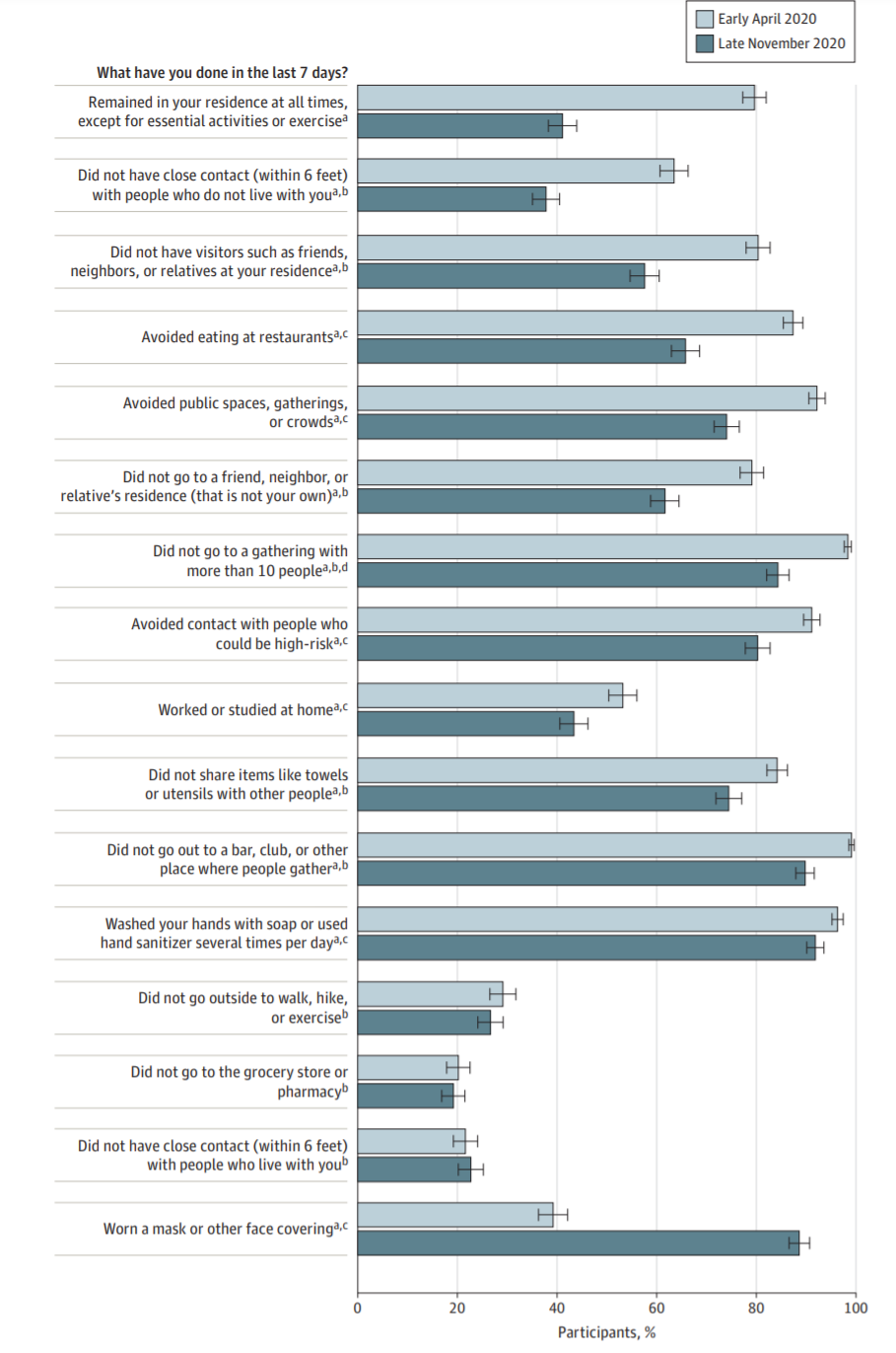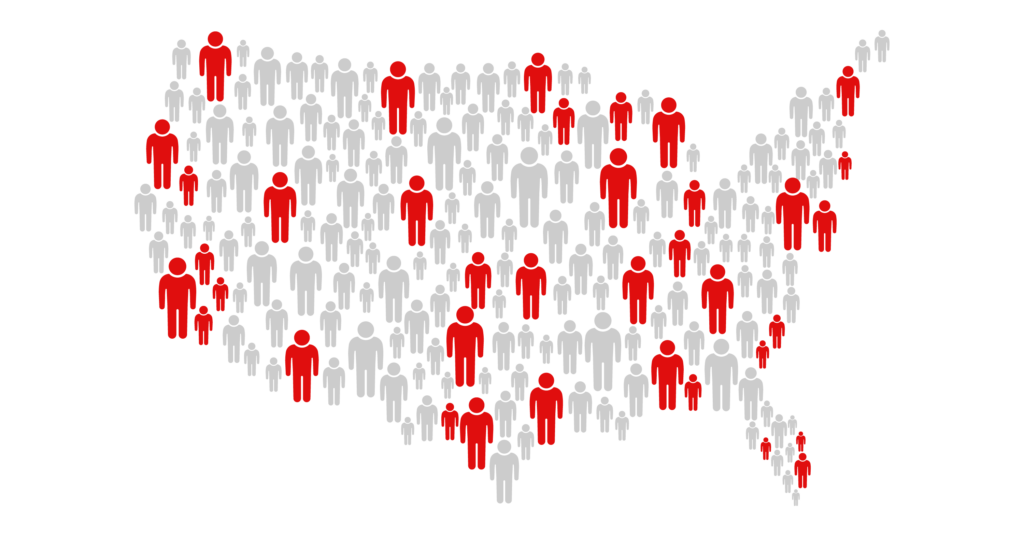Without a vaccine available until recently, behavioral interventions have been strongly relied on to mitigate the spread of COVID-19. Even with a vaccine, public health officials stress that masks and other public health approaches will be vital for weeks and months to come.
Yet, analysis of a survey that was conducted between April and November of 2020 shows a concerning trend: Individuals reported engaging in 16 evidence-based protective measures less frequently in November compared to April. Only mask wearing was up considerably.
“There has been a lot of talk about `pandemic fatigue,’ and this study clearly shows that people are less willing to take precautions to limit the risk of infection and slow the spread of the virus,” said John Romley, lead researcher on the study and senior fellow at the USC Schaeffer Center for Health Policy & Economics.
The study was published January 22 in the Journal of the American Medical Association.
Remaining inside one’s home, having no close contact with non-household members saw large decreases between April and November
The researcher team leveraged a subset of the Understanding American Study, an ongoing panel of U.S. residents. They analyzed 16 waves of survey responses of the Coronavirus Tracking Survey (CTS) completed between April 1, 2020 and November 24, 2020. The survey was sent every two weeks to U.S. residents.
With the data, Romley and his team developed an adherence index to understand whether there was evidence of apathy and resistance toward interventions. Responses were adjusted for sociodemographic characteristics of survey week, age, sex, race/ethnicity, education, household income and 7-day mean of daily new cases in the respondent’s state.
They find that overall adherence on the index decreased substantially from 70.0 (out of a possible 100) in early April to the high 50s in June before increasing to 60.1 by the final wave in late November.
Reported protective behaviors experiencing the largest decreases from early April to late November were:
- remaining inside your home except for essential activities or exercise, which decreased from 79.6% to 41.4%;
- having no close contact with non-household members (63.5% to 37.8%),
- not having visitors over (80.3% to 57.6%), and
- avoiding eating in restaurants (87.3% to 65.8%).
Meanwhile, mask wearing showed a significant increase, from 39.2% in early April to 88.6% in late November.
“The general decrease we see in protective behaviors matches anecdotal reports, but the difference we find between behaviors is a very new and important addition to the conversation,” explained co-author Matthew Crane, a medical student at Johns Hopkins University School of Medicine and a visiting scholar at the USC Schaeffer Center. “Attention to pandemic fatigue is especially relevant given rising concerns about new variants of the virus which may require even greater physical distancing measures to curb transmission.”
The researchers found that these trends occurred in all regions of the U.S.
Figure 1. Adherence to Protective Behaviors in the US During the Coronavirus Disease 2019 Pandemic Among 7705 Adults, April-November 2020.

Figure 2. Adherence to Protective Nonpharmaceutical Interventions (NPIs) in the US During the Coronavirus Disease 2019 (COVID-19) Pandemic, April-November 2020.

Policymakers need to get creative in messaging the importance of sustaining behavior amid growing pandemic fatigue
Within President Biden’s first couple of days in office, he signed 10 directives aimed at changing the trajectory of the COVID-19 pandemic, including a national mask mandate. While mask wearing is very important, Romley says public health officials and policymakers should pay attention to surveys like this and consider the effectiveness of messaging and targeted shutdowns.
“Vaccines are here but vaccination takes time. In the meantime, we need to stay focused on protecting one another. We should target behaviors that are most effective and least disruptive. We also need to recognize that people may be tempted to let down their guards after the first dose of vaccine,” explained Romley.
Developing appropriate public health messaging and targeting behaviors has been a challenge throughout the pandemic.
“To promote vaccine uptake and the continuation of protective behaviors, it’s important to have clear and consistent messages and make it as easy as possible for people to follow recommendations,” explained Wändi Bruine de Bruin, an expert in behavioral sciences and decision making who was not a part of the study. “This may seem obvious but the last year has shown us that this is easier said than done.” Bruine de Bruin is co-director of the Behavioral Sciences Program at the USC Schaeffer Center and a USC Provost Professor of Public Policy, Psychology, and Behavioral Science.
In addition to Romley and Crane, authors of this study include Kenneth Shermock of Johns Hopkins University and Saad Omer of Yale Institute for Global Health.
About the survey: The sample of 7,705 U.S. residents participated in the survey from April 1 to November 24, 2020. The margin of sampling error is +/-2%. Survey respondents are members of USC Dornsife’s Center for Economic and Social Research’s Understanding America Study (UAS) probability-based internet panel. The Coronavirus Tracking Survey has been supported by the Bill and Melinda Gates Foundation, the National Institute on Aging (grant 5U01AG054580-03), and the National Science Foundation (grant 2028683). Information about the survey and the UAS panel, including methodology, question wording and results is available upon request to uas-l@usc.edu and will be posted online when the survey is complete.

You must be logged in to post a comment.